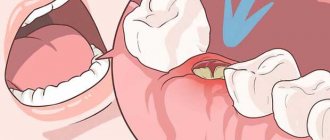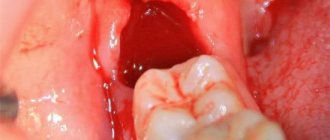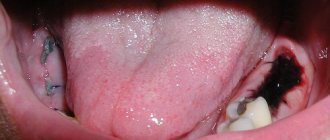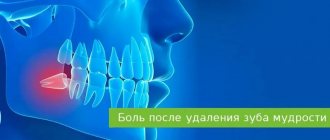From this article you will learn:
- why is my cheek swollen after removal,
- How long does swelling of the cheek or gum last?
- What does the temperature say after tooth extraction?
The article was written by a dental surgeon with more than 19 years of experience.
If your cheek is swollen after tooth extraction, this in most cases is an unfavorable symptom of the development of inflammation, for example, this may indicate the development of alveolitis (suppuration of a blood clot in the socket of the extracted tooth). Swelling of the cheek can also be caused by the formation of a hematoma along the transitional fold, the formation of a purulent abscess on the gum in the area of the extracted tooth, and other reasons.
However, in some cases, swelling after tooth extraction may be natural, without requiring a second visit to the doctor. As you probably know, swelling of the soft tissues after an injury or surgery is the norm, and therefore it is logical after a complex tooth extraction (for example, when the extraction was carried out with an incision in the gums and sawing out the roots of the tooth with a drill).
Swelling of the cheek after wisdom tooth removal –
Moreover, some patients complain only that their gums are swollen after tooth extraction, and they do not have visible swelling of the cheek. The appearance of swelling of the gums has the same reasons (as with swelling of the cheeks), it’s just that there are features of the course of the inflammatory process - depending on the location of the inflammatory focus. For example, if the inflammatory focus is located closer to the transitional fold (i.e., the place where the mucous membrane of the gums enters the cheek), then this is more likely to lead to swelling of the soft tissues of the face.
Below we will examine in detail the cases - when the appearance of edema is quite natural and does not pose a danger, as well as situations in which you urgently need to contact a dental surgeon for a re-examination.
What to do after wisdom tooth removal
On this day, it is better to go home and relax: sleep, read a book, watch your favorite show or movie. It is not recommended to move a lot and intensively, or engage in physical labor.
Starting from the second day, it is necessary to rinse your mouth with antiseptics and take antibiotic medications to prevent the development of infectious and inflammatory diseases. The doctor decides which antibiotics to take after wisdom tooth removal. If there are no recommendations, then you can choose any medications with a wide spectrum of action.
Intense rinsing is not recommended, licking the blood clot is strictly prohibited, otherwise this will lead to the effect of a dry socket. A plug of clotted blood protects the resulting cavity and jaw bones from food particles and bacteria getting inside.
Do not consume hot or too cold foods, drinks, or overheat the body. Visiting the beach, baths, saunas is prohibited.
Smokers will have to give up cigarettes for 2, 3 days, or better yet for a week. Nicotine does not allow the wound to heal quickly, as it constricts blood vessels. Tissues are poorly saturated with oxygen and nutrients, and are more easily susceptible to infection.
A repeated visit to the doctor is necessary, even if the stitches do not need to be removed. The doctor will examine the wound, be able to identify complications in time and prescribe the correct treatment. You should not wait until the date of re-appointment if there is severe, ongoing pain, or the appearance of pus in the socket.
Situations in which swelling is not a cause for concern
In many cases, swelling that occurs after tooth extraction is normal and should not cause alarm.
There is no need to worry if:
- The swelling is mild and does not increase over time. If tooth extraction turned out to be traumatic or was carried out against the background of severe inflammation, then slight swelling is allowed to appear, which should go away on its own in a couple of days.
- Body temperature is slightly elevated, but does not increase over time, or is completely within acceptable values. Removing a tooth when it is inflamed can cause a slight increase in temperature, which, if the source of pain has been eliminated, quickly subsides.
- There is no increasing pain. A sign of normality is the presence of slight pain (after all, removal is a surgical procedure during which soft tissues are injured), gradually decreasing over time. If the pain does not go away, or its strength increases, then this indicates either increasing inflammation or the occurrence of any complications.
- The hole left after the operation is closed with a blood clot. Naturally, after the procedure, the hole is filled with rapidly clotting blood. This clot reliably protects the tissue, preventing the development of an inflammatory process.
After removal, the cheek may look swollen for one day - this is a period during which you should not worry. If after 24 hours there is no obvious deterioration and the swelling decreases, there is no need to waste time on a visit to the dentist. But if at least one of the symptoms listed above is present, this indicates the need to make an appointment with a dentist as quickly as possible in order to prevent the situation from worsening.
If your temperature rises after wisdom tooth removal
The symptom may occur immediately after extirpation. This is due to the action of the immune system in response to tissue injury and invasion of foreign elements into the body.
Doctors recommend taking antipyretics and using cold compresses to remove heat locally.
If the patient then develops a fever several days after extirpation, this may indicate the presence of an inflammatory process. The most common is alveolitis. It is accompanied by acute pain, which can radiate to the throat, temple, ear, depending on where the hole is located. If, when you probe the hole with your tongue, you feel an empty cavity, then you need to urgently go to the dental clinic where the surgery was performed.
When should swelling occur?
There are situations when the development of noticeable edema is inevitable. They arise:
- After an operation of increased complexity. Removal accompanied by damage to nearby tissues (for example, when it is necessary to saw out bone or incisions in the mucous membrane) leads to the appearance of edema. In some situations (for example, when the eighth tooth is removed), facial asymmetry is likely to occur.
- When removed due to severe inflammation. Then an infection remains in the hole, which can become the main cause of swelling. If the operation is carried out in compliance with all the rules, then the dentist, seeing inflammation, is obliged to thoroughly rinse the wound with an antiseptic solution, and then apply the medicine. Sometimes antibiotics are prescribed. However, even then it cannot be said that the inflammatory process will not begin.
- When cutting the gums on which there is an abscess, the dentist makes an incision to release the pus located in the soft tissues. If there was already a slight swelling during the procedure, it may increase slightly in size, which is normal.
- When contacting people suffering from certain diseases. Quite often, according to the observations of dentists, patients who have high blood pressure complain about swelling of the cheek after tooth extraction, leading to the accumulation of a subcutaneous fat layer on the face. In such people, swelling may well appear even with normal removal, which proceeds without any complications.
How to relieve pain after wisdom tooth removal
The doctor prescribes drugs for pain relief to the patient. If there is no list, but the pain is severe, then you can buy Tempalgin, Baralgin, Ketanov and similar medications. Medicines must be taken according to instructions. If you take too many tablets, it will lead to side effects. One tablet is usually enough to stop an attack. Take three times a day.
In addition to medications, pain can be reduced with cold. A cold compress is applied to the cheek for 15 to 30 minutes up to four times a day. You can use pieces of ice or frozen food from the freezer. They are placed in a plastic bag and a towel, and then applied to the sore spot.
In what cases should you consult a doctor?
Have you had your wisdom tooth removed, and after a couple of days or more have you noticed swelling that is increasing? What to do? Such symptoms cannot be ignored. Urgently need to visit the dentist! You should contact the clinic as soon as possible in case of high fever, discharge of pus, growing swelling, severe redness of the gums and bleeding, so that the situation does not worsen. The doctor will take the necessary measures. The patient may need to wash the hole, open the abscess, and prescribe medications.
If your cheek is swollen and hurts, or swelling has taken over the area under the eye, you cannot do without medical help. Monitor your health, and if there is a sharp deterioration, call an ambulance. You should contact your dentist if you have difficulty swallowing, chewing food, or opening your mouth. The patient feels a deterioration in health when the blood clot is washed out of the socket. In its absence, inflammation often appears. Therapy consists of applying medications that will quickly relieve discomfort.
The clot may suppurate and alveolitis may develop. Self-prescribing antibiotics is unacceptable. Only a doctor can alleviate the patient’s condition, clean the hole, and place it in medicine. It happens that a hematoma develops. At first, it does not cause painful attacks or swelling. However, as soon as obvious signs appear, a visit to the dentist is mandatory. The doctor will open the hematoma and prescribe therapy.
What can you eat after wisdom tooth removal?
It is forbidden to put anything in your mouth for two hours after extraction. During this time, a plug of condensed blood is formed and fixed on the socket, which is necessary to protect against the entry of various elements, including pathogens. If you are very thirsty, you can do this through a straw or in small sips.
On the first day, you can drink non-hot drinks and eat liquid porridge, yogurt, and soups. Over the next few days, you should adhere to the following recommendations:
- food must be at a comfortable temperature; hot and too cold food is prohibited, including drinks;
- it is necessary to exclude solid foods that can injure the gums;
- You need to chew food on the side that has not undergone surgery;
- After each dose, you need to rinse your mouth with a warm saline solution;
- If your immune system is weakened, you can take additional multivitamins.
It is better to refuse or limit sweet, spicy foods, alcohol, and carbonated drinks.
Rehabilitation after surgery
The recovery period after bone grafting and sinus lifting includes many nuances and components. Control visits to the dentist, who will assess the dynamics of rehabilitation and correct it, are important. In addition, the doctor looks at the condition of the graft and its survival rate using instrumental studies.
Recommendations during the recovery period are general and specific to the oral cavity. The general pattern of behavior after surgery includes the following principles:
- Quitting smoking;
- Limiting physical activity;
- Avoidance of air travel;
- Refusal from diving;
- Limiting ultraviolet radiation (going to the solarium is prohibited);
- Coughing and sneezing should be done with caution and with the mouth open;
- It is forbidden to blow your nose;
- You should not drink through a straw, as the pressure in the mouth increases;
- Food should be finely ground and warm, but not hot.
Particular attention is paid to proper oral care during the rehabilitation period. The dentist must instruct the patient in detail about all the nuances of this process:
- The operated area is cleaned using a cotton swab and an antiseptic solution (movements should be gentle, in the form of blotting, not rubbing);
- The teeth are cleaned with a soft toothbrush for several weeks after surgery (the postoperative wound is not affected);
- During the day, the oral cavity is treated with an antiseptic solution (but without rinsing);
- Chewing is carried out only on the healthy side (at least a few weeks after bone grafting).
However, the rehabilitation period after bone grafting and sinus lifting, as with any surgical intervention, involves taking a number of medications. The patient should not prescribe or use medications on his own, as this may cause irreparable harm to his own health.
How to rinse your mouth after wisdom tooth removal
The first few hours after extirpation, rinsing is strictly prohibited. This can lead to the natural plug being washed away, exposing the socket and bone. If bacteria penetrate inside, alveolitis or osteomyelitis will develop.
From the second day, carefully, not intensively, rinse your mouth with various antiseptics:
- chlorhexidine;
- miramestin;
- furatsilin;
- diluted potassium permanganate.
At home, you can prepare a solution with salt, soda, and add a few drops of iodine to the water. Herbal decoctions with sage, eucalyptus, chamomile, calendula, and oak bark perfectly relieve swelling and inflammation.
How long does it take for gums to heal after wisdom tooth removal?
It is impossible to answer this question unambiguously, since the answer depends on the following factors:
- difficulties of extirpation - with a simple procedure, the tissues are minimally injured, which means the hole will heal within a few days; with incisions in the gums, the tissues heal for several weeks;
- age - faster for young people;
- the presence of complications, inflammatory processes that delay healing indefinitely until the infection is eliminated;
- compliance with doctor's instructions for the rehabilitation period;
- individual characteristics of the body.











